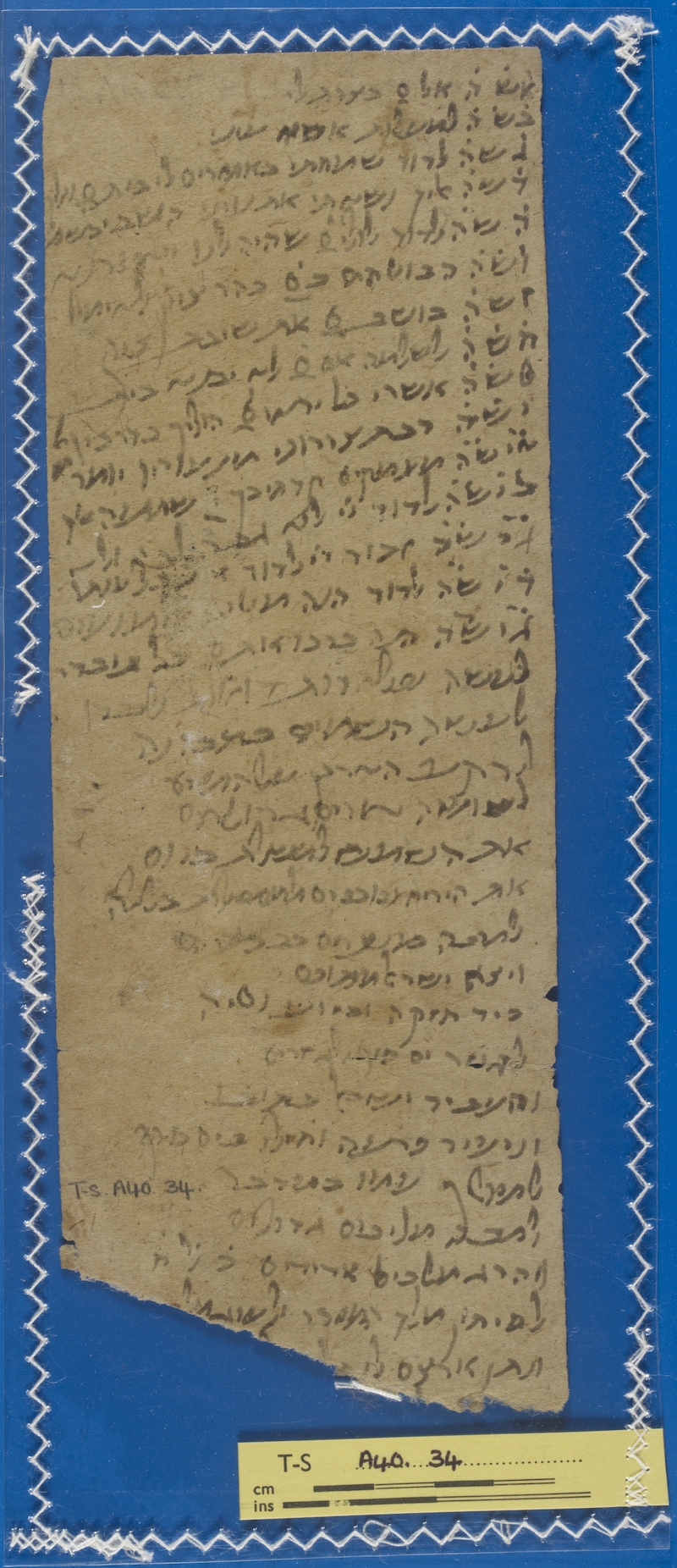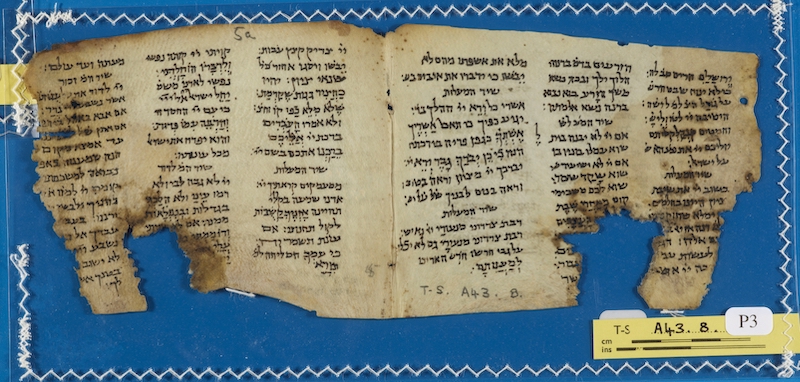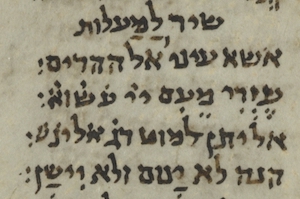A Shorthand Psalter: T-S A43.8
In Fleischer’s monumental work on prayer and prayer ritual in the Palestinian tradition from the classical Genizah period, he uncovers several Palestinian liturgical practices that do not appear to be paralleled in the Babylonian rites. One such practice was the daily reading of all the Psalms of Ascent (Psalms 120-134), usually with Psalms 135-136 as well, as part of the Morning Service1. Inevitably, such regular repetition of these Psalms would have rendered them very familiar, such that at least some of the worshippers would have been able to recite the Psalms with less than a full text in front of them. Indeed, Fleischer found various mnemonic notes, some of them in explicitly liturgical contexts, apparently serving as aides mémoire for the recitation of these Psalms. For example, in the important MS Vienna Wien H96 the following masoretic-style note is given after the relevant section of the liturgy:
וסימן חמשה עשר שיר שהם שיר המעלות שיר למעלות אאשאלה בלא רמיזה
"The siman for the fifteen Songs of Ascents is אאשאלה בלא רמיזה."
Here, the siman consists of the first letter of the first word of each of the Psalms of Ascent (excluding their titles):2
(Ps. 125) הבטחים - (Ps. 124) לולי יי - (Ps. 123) אילך נשאתי - (Ps. 122) שמחתי באמרים לי - (Ps. 121) אשא עיני - (Ps. 120) אל יי
One could argue that, in this case, the siman was simply intended as a piece of masoretic trivia, rather than as a mnemonic tool for recitation. After all, the relevant Psalms are written out in full in this MS. Other MSS, though, are more obviously mnemonic in their function. For example, Fleischer draws our attention to T-S A40.34, a single leaf from a rotulus-style, paper MS (22.5 x 8 cm), written unruled in a cursive Oriental hand. In this fragment the first line (or part thereof) of each of the Psalms of Ascent is written out one beneath the other in a numbered list. Thereafter, the first half of each line of Psalm 136 (beginning at verse 4) is written out:
לעשה נפלאות גדולות לבדו
לעשה השמים בתבונה
לרקע הארץ על המים...

The opening lines of the fifteen Psalms of Ascent, followed by an abbreviated form of Psalm 136, T-S A40.34, recto
With this liturgical context in mind, let’s now consider T-S A43.8: four bifolia from a small album format (10x12cm) parchment Psalter, written, unruled, in three columns of uneven width and with varying numbers of lines. The text is written in an unpractised square hand, partially vocalised and cantillated with Tiberian signs, and with isolated masoretic notes. The extant fragments contain Psalms 119-145.

A shorthand Psalter, T-S A43.8, recto
Much of the text is written in full, but two different methods of abbreviating the text are also much in evidence, one more extreme than the other. The scribe shows a preference for finishing a verse at the end of a line, and uses these two methods of abbreviation for that purpose. The less extreme method of abbreviation involves representing some of the words of the verse by their first few letters only. The more extreme method is simply to omit as much of the end of the verse as is required. Both these methods can be seen at work in Psalm 121:

Detail of T-S A43.8 (P3, verso)
The more extreme method is simply to omit as much of the end of the verse as is required. Both these methods can be seen at work in Psalm 121. Below, for each of the first four verses of this Psalm, the MT is presented first, followed by a transcription of the verse as it appears in T-S A43.8:
שִׁ֗יר לַֽמַּ֫עֲל֥וֹת אֶשָּׂ֣א עֵ֭ינַי אֶל־הֶהָרִ֑ים מֵ֝אַ֗יִן יָבֹ֥א עֶזְרִֽי׃
שיר ֽלַמַעלות אשא עיני אל ההרים׃
עֶ֭זְרִי מֵעִ֣ם יְהוָ֑ה עֹ֝שֵׂ֗ה שָׁמַ֥יִם וָאָֽרֶץ׃
עֶזְרִי מֵעִם ייי ע֗ ש֗ וא֗׃
אַל־יִתֵּ֣ן לַמּ֣וֹט רַגְלֶ֑ךָ אַל־יָ֝נ֗וּם שֹֽׁמְרֶֽךָ׃
אל יתן למוט רג֗ אל ינ֗ ש֗׃
הִנֵּ֣ה לֹֽא־יָ֭נוּם וְלֹ֣א יִישָׁ֑ן שׁ֝וֹמֵ֗ר יִשְׂרָאֵֽל׃
הנה לא יָנום ולא יִישָן׃
As the transcriptions above demonstrate, in verses 1 and 4 the scribe has completely omitted the final few words of the verse; the reader is expected to complete the text from memory. In verses 2 and 3 the scribe has represented each of the latter words of the verse using only their first one or two letters.
The small size of this MS (each column is only 2.5 cm wide), and its rather workmanlike script and layout, suggest that it was a personal production for individual use in personal and liturgical contexts. We can imagine a worshipper using this very codex in the Morning Service a thousand years ago, occasionally glancing at the abbreviated text as a sufficient aid to assist him in the recitation of Psalms he had been reciting from his youth.
Indeed, one further aspect of the use of abbreviations in this text would appear to link the MS to the Eretz Yisraeli Morning Service rather clearly. We have seen that the scribe uses two different methods to abbreviate the text: the ‘first-letters-only’ method, and the more extreme ‘amputation’ method. However, these two different abbreviation techniques are not spread out evenly across all the extant text of the Psalter. In the 130 extant verses of Psalm 119, the scribe uses the amputation method only twice (vv. 43 and 65), but uses the first-letters-only method dozens of times (usually giving the first two or three letters of some words, with the other words of the verse written in full). In the Psalms of Ascent, however, the scribe uses the amputation method in dozens of verses, as well as the first-letters-only method. This results in a far more densely abbreviated text. In a sample of 50 verses from the Songs of Ascent, 32 of those verses were ‘amputated’. In 17 verses the abbreviation was light (only one or two words were omitted from the end of the line), but in 15 verses the abbreviation was heavy (more than two words were omitted from the end of the line), as in the following examples:
Psalm 122: 1-3 (T-S A43.8 P3, verso)
שיר המ׳ לדוד
שמחתי באמרים לי [בית יי נלך]
עמדות היו רגלינו [בשעריך ירושלם]
ירושלם הבנויה כ[עיר שחברה־לה יחדו]
Psalm 125:2 (T-S A43.8 P3, recto)
ירושלם הרים סב׳ לה [ויי סביב לעמו מעתה ועד־עולם]
It does not seem coincidental that the extent of the use of abbreviations markedly increases when the scribe reaches the Psalms of Ascent. These are the Psalms with which he would have been most familiar due to their daily recitation in the Morning Service. In other words, we can detect echoes and traces of the Eretz Yisraeli liturgy in the very manner in which the text of the Psalms is inscribed on the parchment.
Every manuscript is a palimpsest. For every manuscript not only carries symbols from a previous era (in this case, prayers from deep antiquity), but also indelible marks from the era in which the manuscript itself was produced. In this particular manuscript, in the very writing - and omitting - of words, the liturgy of Ancient Israel mingles and blends with that of the mediaeval Eretz Yisraeli synagogue.
Footnotes
1 The situation on the ground appears to have been rather more variegated than this one sentence summary implies. See Ezra Fleischer, תפילה ומנהגי תפילה ארץ ישראליים בתקופת הגניזה (Jerusalem: Magnes Press, 1988), 215–258, esp. 232ff., for fuller details. Nonetheless, on the basis of the MS evidence, it would appear that many, if not most, Eretz Yisraeli synagogues recited at least these Psalms daily.
2 In its current state, the siman has only 14 letters; the last Song of Ascent is not represented. An additional ה ought therefore to be added to the end of the siman.
Cite this article
Phillips, K. (2020). A Shorthand Psalter: T-S A43.8. [Genizah Research Unit, Fragment of the Month, May 2020]. https://doi.org/10.17863/CAM.65549
If you enjoyed this Fragment of the Month, you can find others here.
Contact us: genizah@lib.cam.ac.uk
